Fluxor
Harmless

Posts: 24
Registered: 18-7-2009
Member Is Offline
Mood: No Mood
|
|
"chemical chameleon" experiment & "Crystal Drano" (impure NaOH)
Today, in my new garage lab, I attempted for the first time the classic experiment "chemical chameleon" - with disappointing results. It failed to
work.
I attribute the failure to the fact that I used impure NaOH (Crystal Drano clog remover), however, I haven't enough chemical knowledge yet to say what
caused it to fail beyond the mere conjecture that it was the Crystal Drano. I've only recently embarked on this wonderful hobby of home chemistry. The
Crystal Drano is mostly NaOH, but also has NaNO3, NaCl, and Al bits:
http://householdproducts.nlm.nih.gov/cgi-bin/household/brand...
The procedure I used was from Wilco Oelen's excellent site, "Science Made Alive." As per the procedure, I dissolved 0.55 g of Crystal Drano into 100
ml of water. Then dissolved 1.54 g sucrose. I swirled in an erlenmeyer to dissolve the reactants. I immediately noticed that several shrapnel-like
bits of metal settled on the bottom of the flask and refused to dissolve.
I then added a few ml of 0.01% w/v solution of KMnO4 to the erlenmeyer with the Crystal Drano and the sucrose. I swirled until dissolved to a
colorless solution (happened right away). Then I let it sit, waiting for the chameleon-like changes to begin. But the solution remained colorless and
the color changes never occurred.
I have attached some photos to represent my set up.
I was wondering if maybe some of you more experienced home chemists could provide some insight here -- could one or more of the impurities in the
Crystal Drano have prevented the change in oxidation states of the Mn ion?
I appreciate greatly your comments and knowledge as to why exactly the experiment failed and whether my conjecture is right (impure NaOH).
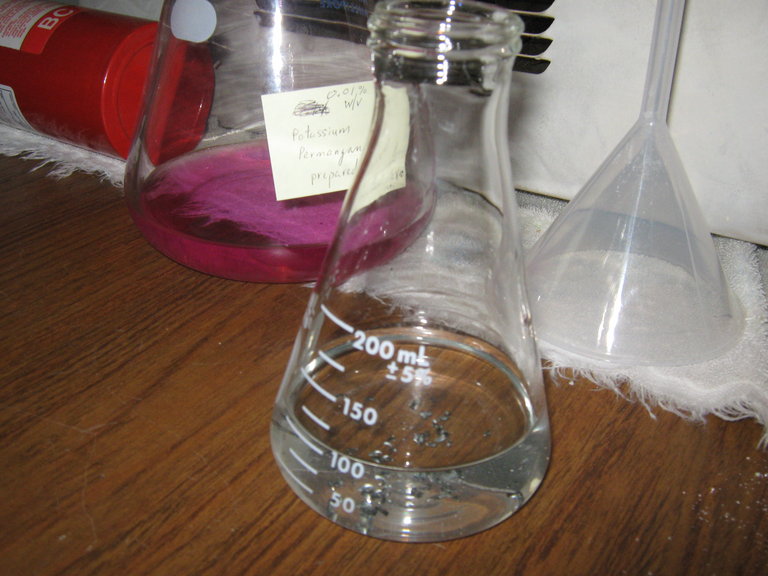 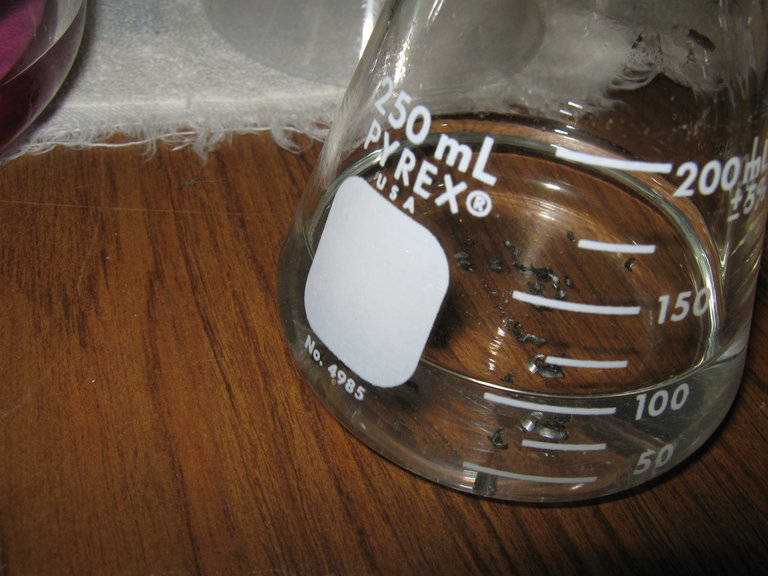
|
|
|
not_important
International Hazard
    
Posts: 3873
Registered: 21-7-2006
Member Is Offline
Mood: No Mood
|
|
First off I'd say your KMnO4 solution is a little too dilute, add a bit more KMnO4 to it until it is a strong but transparent purple - remember you
are adding it to another solution.
Second, the mixture turned colourless, which means you've no higher oxidation states of manganese in it. To me it looks slightly cloudy, although that
could be lighting.
I'd say that the Al reduced your KMnO4 down to Mn(2+), which has precipitated as the nearly white hydroxide.
Try pouring a bit (a gram or two) of Drano into a glass or plastic dish, so that you have a shallow pile in one part of the dish. Use a spatula or
some similar thin object to quickly separate the Al chunks from the rest of the mixture; it's going to absorb water from the air so you need to
be quick. Then scoop up the remaining Drano and add it to 1/4 the total water for the sugar-NaOH solution, do it in the flask to reduce the chance
if any splurting out. Carefully swirl it to get it to dissolve, note if any Al was left and if it starts to react; let it sit for a few minutes if
there is some Al but it just sits there. If nothing happens in that time, warm the solution until gas bubbles start to appear on the Al. You want
any Al that didn't get separated to react with the NaOH and dissolve or form a whitish precipitate/gel.
If there's no Al, or it has now all dissolved, add the rest of the water and then the sugar, and proceed as before. You still want the KMnO4 to be
twice as strongly coloured as the stuff in your photo is, it should make the other solution distinctly purple when added, not just a pink-purple tint.
|
|
|
Fluxor
Harmless

Posts: 24
Registered: 18-7-2009
Member Is Offline
Mood: No Mood
|
|
not_important ,
Thank you for that. Will try your separation method with the spatula, and getting any possible Al to react with the NaOH before adding rest of the
water and sugar. Will also see about making up a more concentrated KMnO4 solution to make it more purple (maybe I'll try at 10 x more concentrated:
0.1% w/v).
Thank you again for your insight and help!
|
|
|
woelen
Super Administrator
        
Posts: 8012
Registered: 20-8-2005
Location: Netherlands
Member Is Offline
Mood: interested
|
|
In fact, your experiment was successful, but it was way too fast. In my experiment it takes tens of seconds, in your experiment it takes a fraction of
a second.
If you look very carefully then you'll see that your solution is not really colorless but somewhat cloudy and very opale yellow. Indeed, increase the
concentration of the permanganate somewhat (but not too much, its concentration should just be two or three times higher). But most important is that
you remove the Al-granules from your drain cleaner. The Al-metal quickly reduces the permanganate to oxidation state +4 (or maybe even +2). This
reaction is very fast, much and much faster than the reaction with the sugar.
|
|
|
Fluxor
Harmless

Posts: 24
Registered: 18-7-2009
Member Is Offline
Mood: No Mood
|
|
Thank you
Thank you woelen, for your informative reply. And for providing a valuable means by which to learn through your excellent experimentation web site.
The perspicacity and insights you share on the subject make the enjoyment of the hobby increase tenfold.
I will increase the concentration of the permanganate solution, 2 to 3 times of what I had used and try again. Indeed, the NaOH solution that obtained
never became completely clear, but was at all times slighty whitish and cloudy, as not_important pointed out. At the time, I could not explain it,
other than to ascribe it as likely having to do with the impurities..somehow..
That an oxidation change happened very fast instead of not at all, did not occur to me. I am at this moment still reading up on the nature of redox
reactions and of oxidation in general and so my understandings are still
quite incomplete.
I will try the experiment again, per yours and not_important's suggestions. I am excited by the prospect of more experimenting and "attaining
understanding" of what's going on.
Thanks again,
C
|
|
|
Fluxor
Harmless

Posts: 24
Registered: 18-7-2009
Member Is Offline
Mood: No Mood
|
|
2nd experiment results
Well, last night I carried out a 2nd experiment in order to obtain the "chemical chameleon", but unfortunately, still no color changes were observed.
I doubled the concentration of the KMNO4 solution from 0.01% w/v to 0.02% w/v, as was suggested to me after the 1st attempt. I also removed with
forceps all of the little bits of Al in the Crystal Drano, but left some light blue-colored spheres (see attached pic).
quantities used:
0.51 g NaOH (Crystal Drano, with Al bits removed but with "blue spheres")
1.46 g sucrose (table sugar)
0.02% w/v KMNO4 (a few mL)
When I dissolved the NaOH, the sucrose, and the KMNO4 solution in the erlenmeyer, no cloudiness was observed. It dissolved into a colorless solution.
I think that the problem may be that KMNO4 solution is still too dilute. I will try it next with a 0.03% solution. Also, perhaps the "blue spheres"
left in the Crystal Drano are acting to speed up the change in oxidation states, to the point that the color changes happen in fractions of a second,
as had happened the first time. If this is the case, I will try removing the "blue spheres" as well, although they are probably merely NaOH granules
in spherical form??
Does anyone have any further ideas or suggestions?
Thanks mightily for the help you have given.
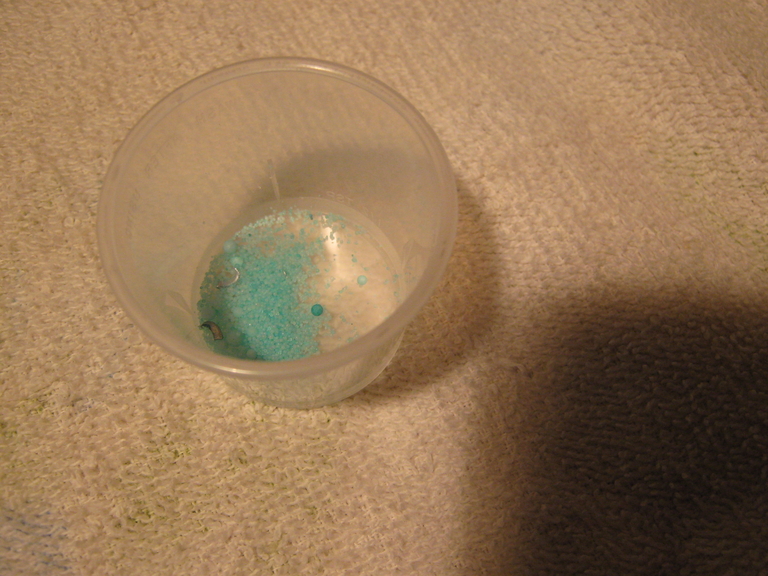 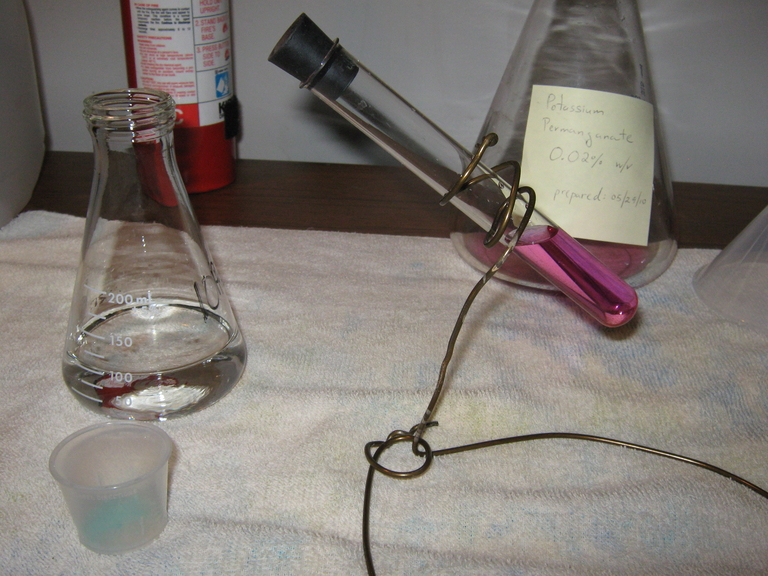 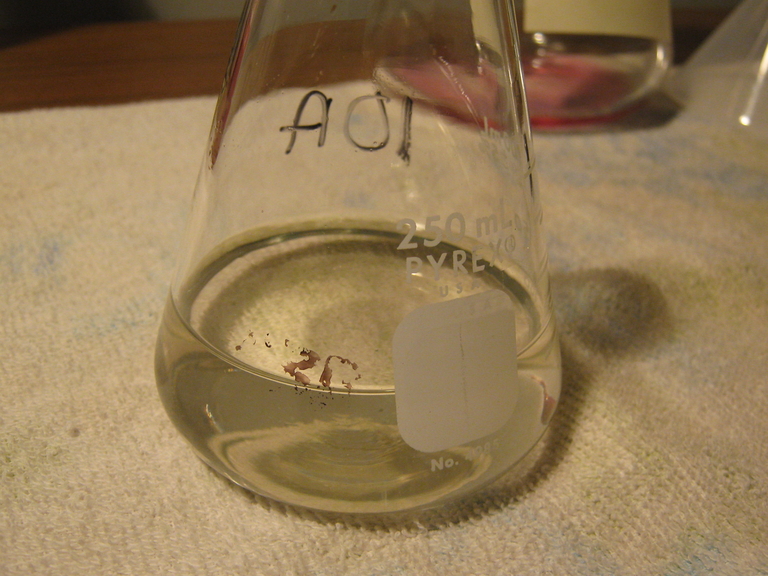
[Edited on 13-6-2010 by Fluxor]
[Edited on 13-6-2010 by Fluxor]
|
|
|
Lambda-Eyde
National Hazard
   
Posts: 860
Registered: 20-11-2008
Location: Norway
Member Is Offline
Mood: Cleaved
|
|
It's nice to see someone who's genuinely interested in science.
I'd try the experiment with an even stronger solution of KMnO<sub>4</sub>. Judging from the color, that's a very dilute solution. I have
successfully done this experiment and I used an almost saturated solution, IIRC.
A 0,02M solution of KMnO<sub>4</sub> is opaque in a 500 ml bottle.
|
|
|
woelen
Super Administrator
        
Posts: 8012
Registered: 20-8-2005
Location: Netherlands
Member Is Offline
Mood: interested
|
|
I am afraid that you need to use another source of NaOH. NaOH is perfectly white and not green like you show in the picture. In the Netherlands we
also have such a green drain cleaner and the green stuff seems to be some perfume-like compound (smells a little bit like oil of wintergreen) and
under the strongly alkaline conditions, this works as a fairly strong reductor which reduces the permanganate at once. Keep in mind that permanganate
at very high pH is a surprisingly strong oxidizer, capable of completely oxidizing (destroying) many organic molecules. You have to look for true NaOH
without the green additive.
|
|
|
Fluxor
Harmless

Posts: 24
Registered: 18-7-2009
Member Is Offline
Mood: No Mood
|
|
Will get higher-purity NaOH and increase conc of KMNO4
Thank you Lambda-Eye and woelen. I will make the recommended changes to my materials and press forward in my experimenting.
|
|
|
Sedit
International Hazard
    
Posts: 1939
Registered: 23-11-2008
Member Is Offline
Mood: Manic Expressive
|
|
Quote: Originally posted by woelen  | I am afraid that you need to use another source of NaOH. NaOH is perfectly white and not green like you show in the picture. In the Netherlands we
also have such a green drain cleaner and the green stuff seems to be some perfume-like compound (smells a little bit like oil of wintergreen) and
under the strongly alkaline conditions, this works as a fairly strong reductor which reduces the permanganate at once. [rquote]
In the US we have a simular looking crystal drain cleaner that contains sodium nitrate. |
Knowledge is useless to useless people...
"I see a lot of patterns in our behavior as a nation that parallel a lot of other historical processes. The fall of Rome, the fall of Germany — the
fall of the ruling country, the people who think they can do whatever they want without anybody else's consent. I've seen this story
before."~Maynard James Keenan
|
|
|
Fluxor
Harmless

Posts: 24
Registered: 18-7-2009
Member Is Offline
Mood: No Mood
|
|
[rquote]In the US we have a simular looking crystal drain cleaner that contains sodium nitrate. [/rquote]
Sedit, yes, Crystal Drano Clog Remover has 15 - 40% sodium nitrate. The actual product container does not list these impurities and at the time I
purchased it, I had not checked the household products database. I wrongly supposed this product was "99% NaOH" and later, when I did check it, didn't realize that the NaNO3 or other
ingredients could act as a reductor of the permanganate ion.
[Edited on 13-6-2010 by Fluxor]
|
|
|
The WiZard is In
International Hazard
    
Posts: 1617
Registered: 3-4-2010
Member Is Offline
Mood: No Mood
|
|
Quote: Originally posted by woelen  | | I am afraid that you need to use another source of NaOH. molecules. You have to look for true NaOH without the green additive. |
-----------
My local Lowe's sells Roebic - Crystal Drain Opener,
in 2-pound bottles.
Sez on la label - "... is 100% sodium hydroxide."
I use it to dissolve white arsenic. Say did you know this
was patented!
|
|
|
Fluxor
Harmless

Posts: 24
Registered: 18-7-2009
Member Is Offline
Mood: No Mood
|
|
Quote: Originally posted by The WiZard is In  | Quote: Originally posted by woelen  | | I am afraid that you need to use another source of NaOH. molecules. You have to look for true NaOH without the green additive. |
-----------
My local Lowe's sells Roebic - Crystal Drain Opener,
in 2-pound bottles.
Sez on la label - "... is 100% sodium hydroxide."
I use it to dissolve white arsenic. Say did you know this
was patented! |
I found this interesting thread on lye drain cleaner: http://www.sciencemadness.org/talk/viewthread.php?tid=6478
Apparently, since the disappearance of Red Devil Lye, Rooto Household Lye and Roebic are two of the more common sources of OTC 100% NaOH.
|
|
|
Fantasma4500
International Hazard
    
Posts: 1681
Registered: 12-12-2012
Location: Dysrope (aka europe)
Member Is Offline
Mood: dangerously practical
|
|
~~sorry for reviving thread~~
i filmed a ~approx 45L chemical chameleon, pretty decent results, ill up on youtube soon and try to remember to link to it here
it lasted about .. well.. many minutes and it was a great success
45L max 0.3g KMnO4
~200 mL NaOH/KOH solution, store bought
~50g sugar
|
|
|
Brain&Force
Hazard to Lanthanides
    
Posts: 1302
Registered: 13-11-2013
Location: UW-Madison
Member Is Offline
Mood: Incommensurately modulated
|
|
This I got to see...Next time use excess hydrogen peroxide as a reducing agent (3% appears to be sufficient). It's a whole lot more spectacular with
the continuous bubbling of oxygen.
At the end of the day, simulating atoms doesn't beat working with the real things...
|
|
|
Fantasma4500
International Hazard
    
Posts: 1681
Registered: 12-12-2012
Location: Dysrope (aka europe)
Member Is Offline
Mood: dangerously practical
|
|
sorry for ultra long response time, forgot to check up on thread..
http://www.youtube.com/watch?v=Ee8nJIjTV5U&list=UUy29cCM...
with H2O2 -- ill try, i managed to get a bulk amount of 12% H2O2
bulk is good 
|
|
|